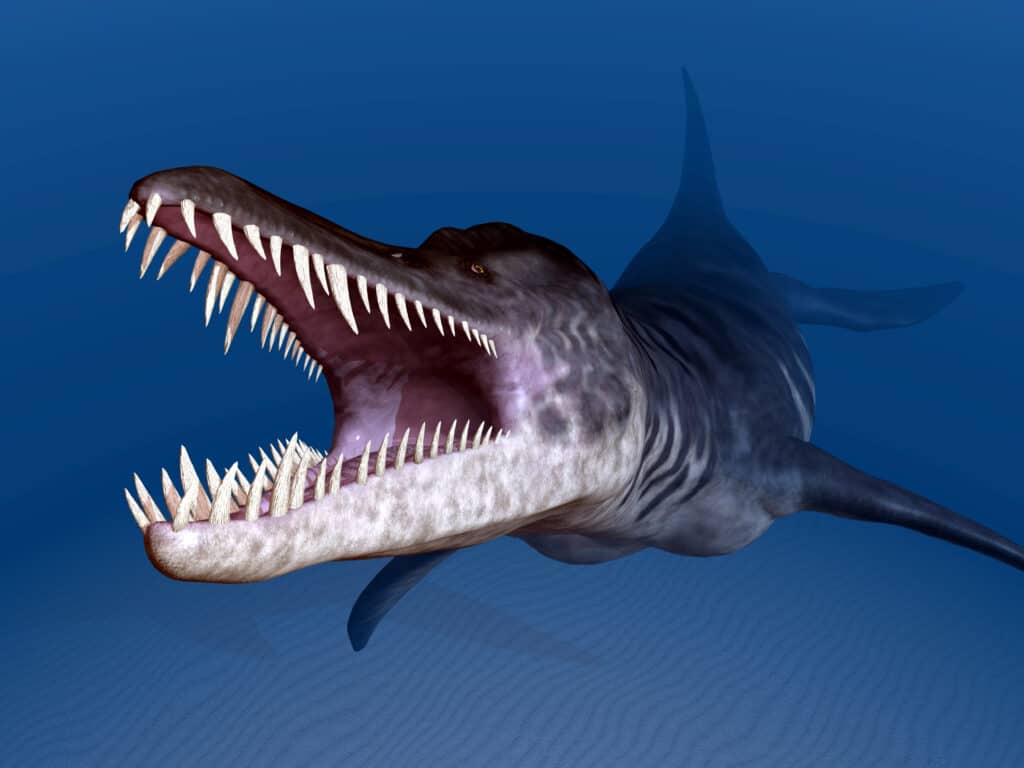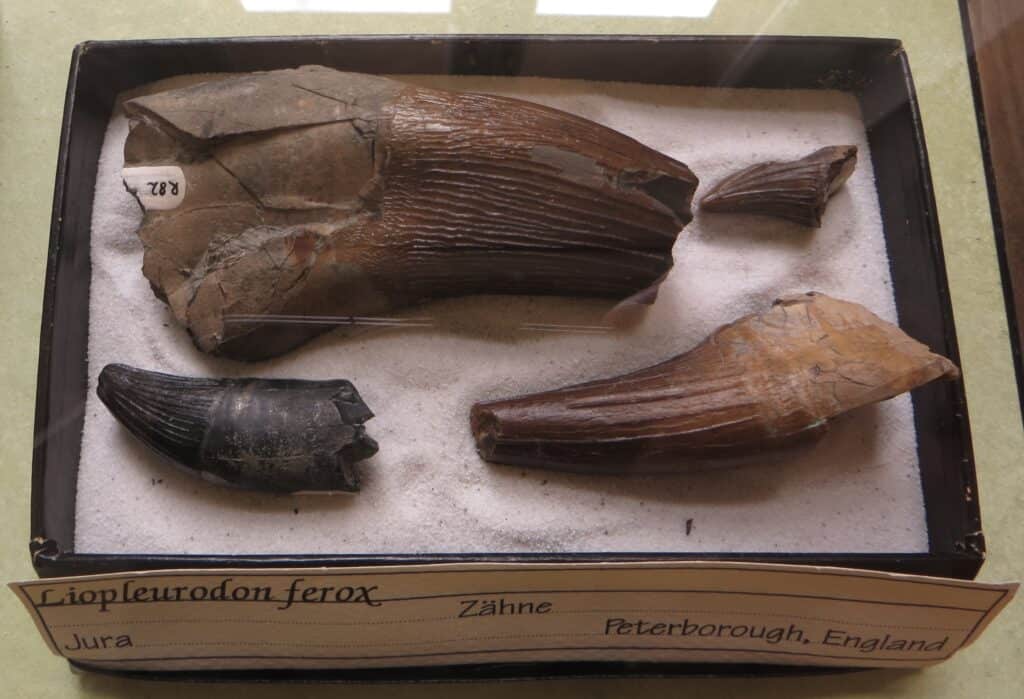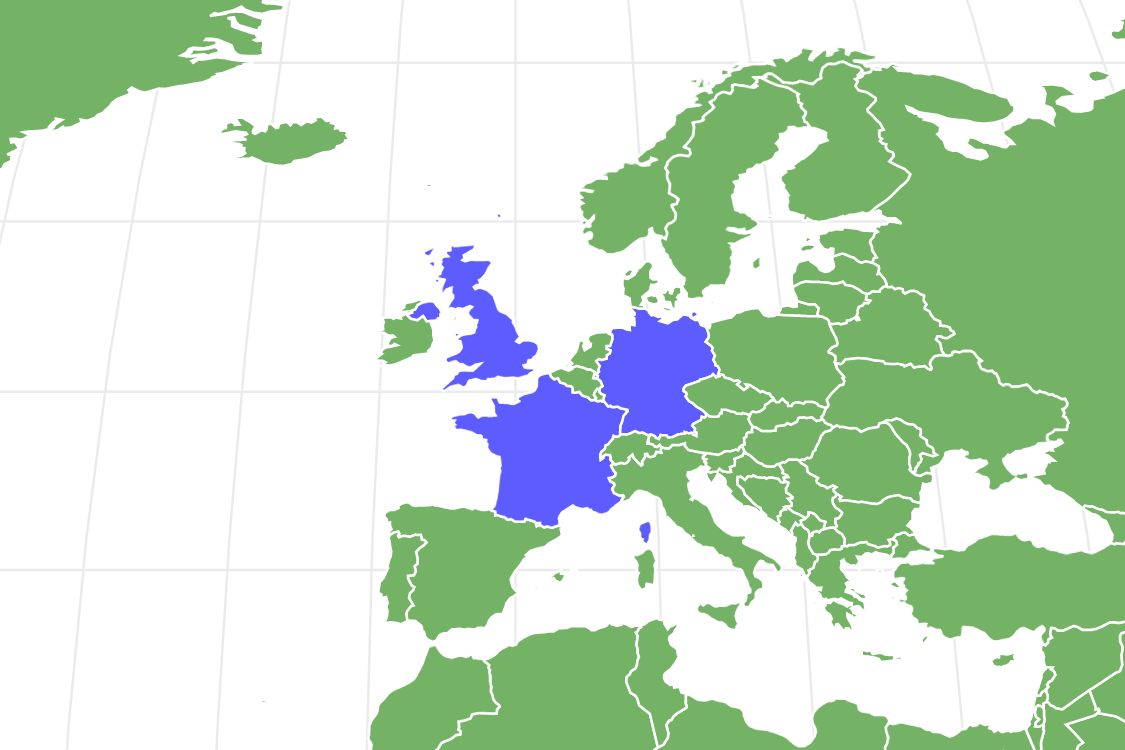Liopleurodon
Liopleurodon ferox
Liopleurodon were fast swimmers that lived entirely under water, but they had no gills
Advertisement
Liopleurodon Scientific Classification
- Kingdom
- Animalia
- Phylum
- Chordata
- Class
- Reptilia
- Order
- Plesiosauria
- Family
- Pliosauridae
- Genus
- Liopleurodon
- Scientific Name
- Liopleurodon ferox
Read our Complete Guide to Classification of Animals.
Liopleurodon Conservation Status
Liopleurodon Facts
- Prey
- Marine reptiles like the Kimmerosaurus, fish, squids, and other smaller animals
- Main Prey
- Smaller marine reptiles
- Fun Fact
- Liopleurodon were fast swimmers that lived entirely under water, but they had no gills
- Biggest Threat
- Most Distinctive Feature
- The Liopleurodon had a massive head and short neck
- Habitat
- Shallow marine habitat
- Diet
- Carnivore
- Location
- Europe
Liopleurodon Physical Characteristics
- Weight
- 2,200–3,700 lb
- Length
- 16–23 ft
- Venomous
- No
- Aggression
- Low
View all of the Liopleurodon images!
Liopleurodon is a genus of massive carnivorous reptiles that lived from the Middle to Late Jurassic period (about 160 million years ago) in a prehistoric sea that covered most of present-day Europe. Although this giant creature lived alongside the dinosaur, it wasn’t one. It belonged to a group of marine reptiles known as plesiosaurs. Fossils of the Liopleurodon have been found across various locations in England, France, and Germany.
Description and Size
Liopleurodon is a genus of carnivorous marine reptiles that lived during the Jurassic period. It belonged to the order Plesiosauria. Scientists have grouped the ancient order of marine reptiles into two families: pliosaurs and plesiosaurs. The Liopleurodon is in the former category. Like the other pliosaurs, it had a long head, a short neck, and a thick torso with long flippers. This contrasts with the plesiosaur’s incredibly long neck and short torso.
The name of this marine reptile means “smooth-sided teeth” in Greek. Paleontologists assigned this name to the creature based on three smooth-sided teeth fossils recovered from a town in France in 1873. Each of the teeth was about three inches long, without any identifying characteristics. This is why scientists refer to it as smooth-sided.
This reptile was an apex predator in its time, thanks to its massive size. Although earlier estimates of this reptile’s size were highly exaggerated, scientists have since corrected this to a more conservative range. Estimating the exact size has been a little difficult because of limited postcranial fossils. Paleontologists believe that the skull of the pliosaurs was about one-seventh of their body. Based on this ratio, the length of the Liopleurodon has been estimated to be about 33 ft. However, most would have an average size of 16-23 ft. Their weight is about 2,200 to 3,700 lb.
Aside from their massive head, another impressive aspect of the Liopleurodon’s anatomy is their strong paddle-like limbs. This four-flipper propulsion was characteristic of all plesiosaurs. They were all powerful swimmers, with the flippers giving them impressive acceleration.

was a carnivorous marine reptile with a long head, short neck, thick torso and long flippers.
©Michael Rosskothen/Shutterstock.com
Diet — What Did Liopleurodon Eat?
Liopleurodon was a carnivore and an apex predator that ruled the Jurassic seas for several million years. With such a massive skull and formidable jaws, this reptile would have had a bite force powerful enough to take down many other marine dinosaurs.
Paleontologists also think this creature was a well-adapted hunter because it had a great sense of smell. They came to this conclusion based on the arrangement of the Liopleurodon’s nostrils which suggests that they could smell prey even when it was still out of their visual range, just like sharks can do today. The Liopleurodon’s diet consisted of prehistoric marine reptiles like the Kimmerosaurus. It would have eaten fish, squids, and other smaller marine animals.

was a carnivore and an apex predator with a bite force powerful enough to take down many other marine dinosaurs.
©Catmando/Shutterstock.com
Habitat — When and Where It Lived
The Liopleurodon was a fully aquatic reptile that lived about 160 million years ago during the Jurassic period. At the time, most of present-day western Europe was covered by a shallow body of water with a thriving population of plesiosaurs and pliosaurs. Like many other marine reptiles of their time, Liopleurodon did not have a gill even though they lived entirely underwater. This means they had to break the surface once in a while to take a gulp of air like present-day marine mammals, such as whales.
Threats and Predators
Given the massive size of the Liopleurodon, it’s doubtful if it would have had any natural enemies that were big enough to take it on except members of its own clade. Larger plesiosaurs most likely preyed on smaller ones quite frequently.
Discoveries and Fossils — Where Liopleurodon Was Found
The major highlight of Liopleurodon’s discovery was their smooth teeth, which lacked any defining features. Interestingly, paleontologists had found smooth-tooth fossils like this even before the Liopleurodon was officially named. Many of these finds were wrongly ascribed to other plesiosaurs.
In 1873, Henri Emile Sauvage eventually coined the genus Liopleurodon after discovering 3-inch-long teeth fossils near Boulogne-sur-Mer, France. He found the fossils in rock layers dating back to the Jurassic period. The species was given the name Liopleurodon ferox.
Later, scientists found another tooth fossil about 2.8 inches long in Charly, France. It was given the name Liopleurodon grossouvrei. They discovered the third near Caen, France, which was named Liopleurodon bucklandi.

The name
Liopleurodonmeans “smooth-sided teeth” in Greek. Paleontologists assigned this name based on teeth fossils recovered in France in 1873.
©Ghedoghedo, CC BY-SA 4.0 <https://creativecommons.org/licenses/by-sa/4.0>, via Wikimedia Commons – License
Extinction — When Did It Die Out?
Despite being apex predators in their time, Liopleurodons eventually lost their dominance by the start of the Cretaceous period about 150 million years ago. The appearance of the mosasaurs, a group of vicious and better adapted marine reptiles, threatened the dominance of the plesiosaurs. With time, they outcompeted Liopleurodon and their close cousins. By the time the Cretaceous–Tertiary extinction occurred about 65 million years ago, they had all but disappeared.
Similar Animals to the Liopleurodon
Similar dinosaurs to the Liopleurodons include:
- Megacephalosaurus: Megacephalosaurus is an extinct pliosaur genus with a massive head. It lived in the Western Interior Seaway of North America during the Cretaceous and was among the largest marine reptiles ever.
- Plesiosaurus: This is a genus of extinct marine reptiles that lived during the Early Jurassic. They’re known for their long neck, which is significantly longer than the Pliosaurs.
- Ichthyosaurus: This is a large group of fish-like marine reptiles that lived in Europe from the early Jurassic to the Late Jurassic.
Related Animals
View all 98 animals that start with LLiopleurodon FAQs (Frequently Asked Questions)
When were the Liopleurodons alive?
Liopleurodons lived about 160 to 150 million years ago. Some species like the Liopleurodon ferox and Liopleurodon pachydeirus lived during the Middle Jurassic Period. Others, like the Liopleurodon rossicus, lived during the Late Jurassic.
How big were Liopleurodons?
The largest Liopleurodons were up to 33 ft. However, the average size of most was about 16 to 23 ft. Their weight has been estimated to have been about 2,200 to 3,700 lb.
Was Liopleurodon a mosasaur?
No, Liopleurodons were not the same as the mosasaurs. In fact, both groups are not related, with the mosasaurs appearing much later during the Late Cretaceous while Liopleurodons lived during the Jurassic.
Thank you for reading! Have some feedback for us? Contact the AZ Animals editorial team.
Sources
- Dinopedia, Available here: https://dinopedia.fandom.com/wiki/Liopleurodon
- CriiterFacts, Available here: https://critterfacts.com/liopleurodon/?doing_wp_cron=1663914378.3714959621429443359375
- Wikipedia, Available here: https://en.wikipedia.org/wiki/Liopleurodon

















